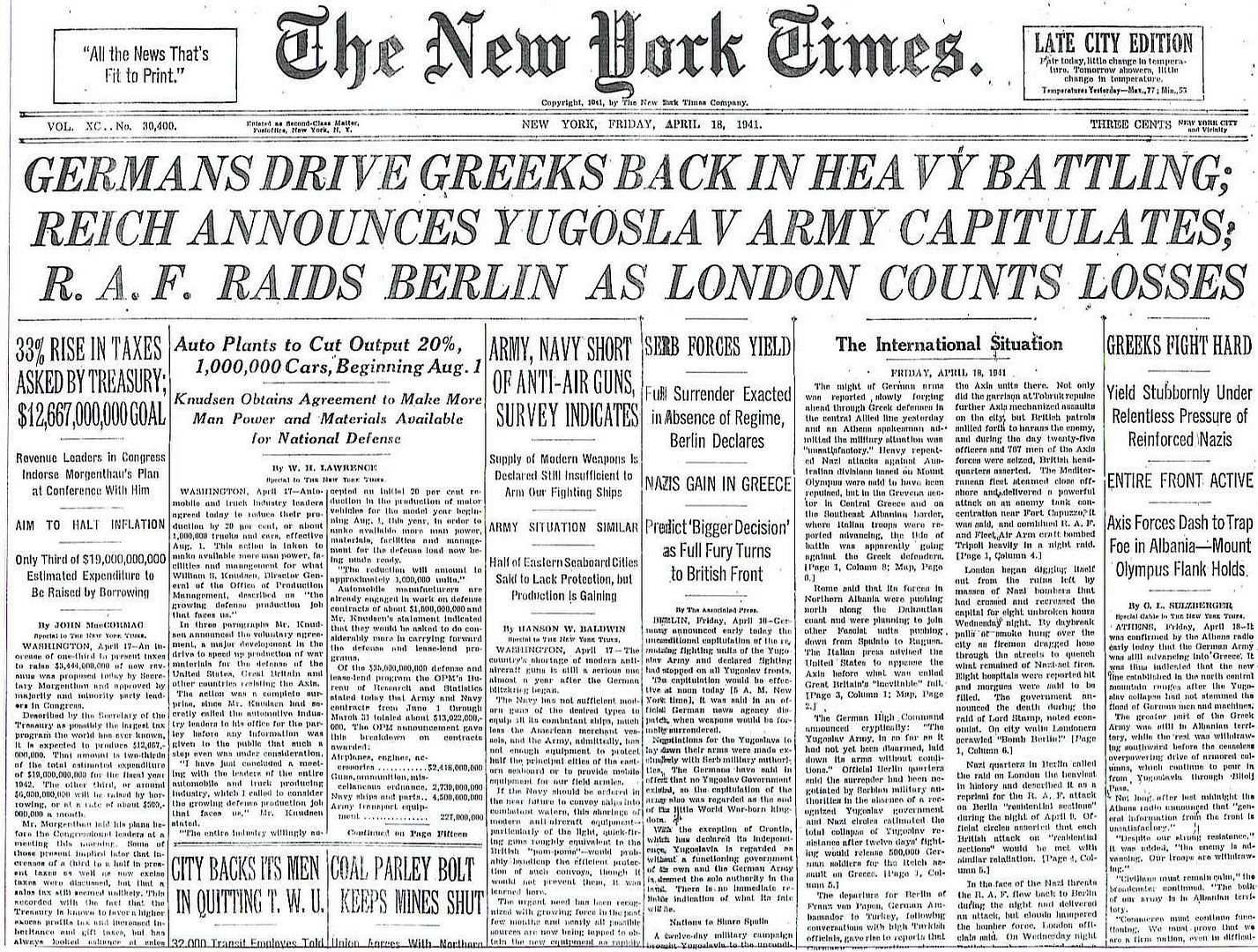
Posted on 04/18/2011 4:55:47 AM PDT by Homer_J_Simpson


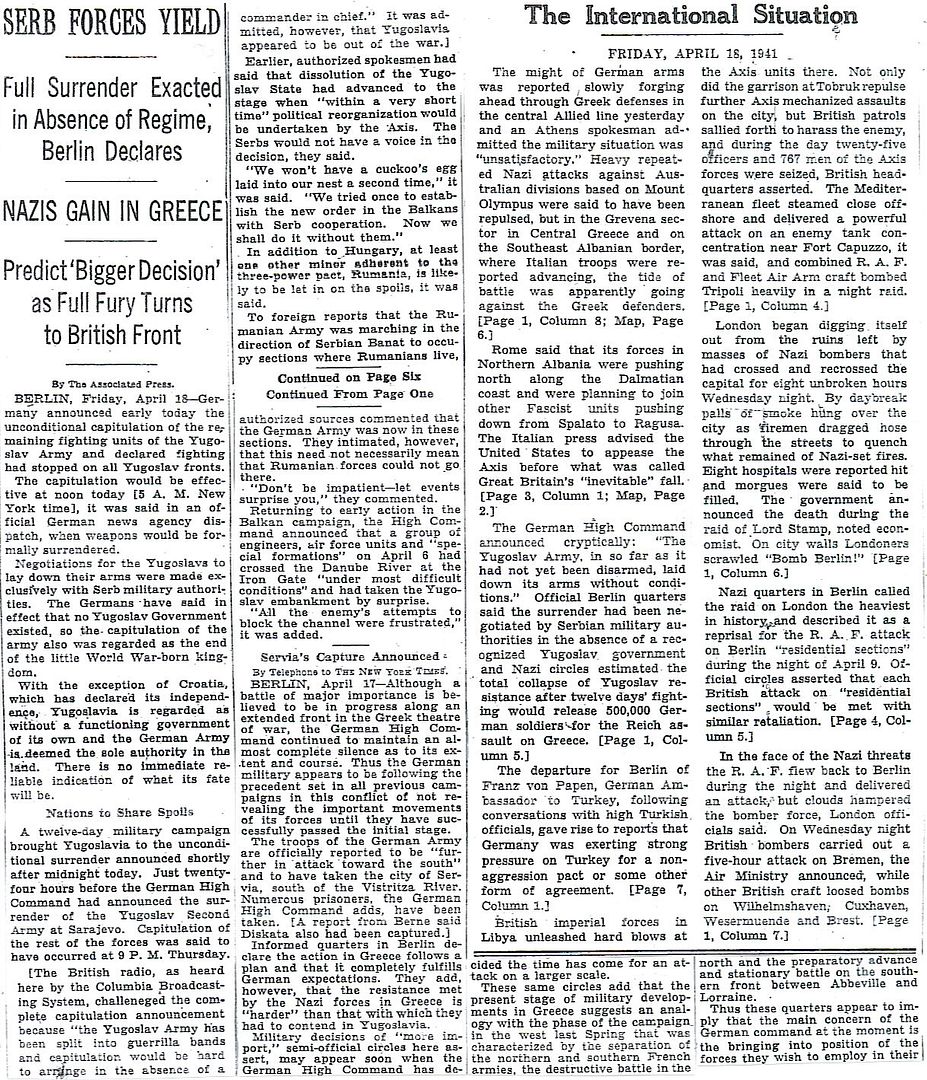
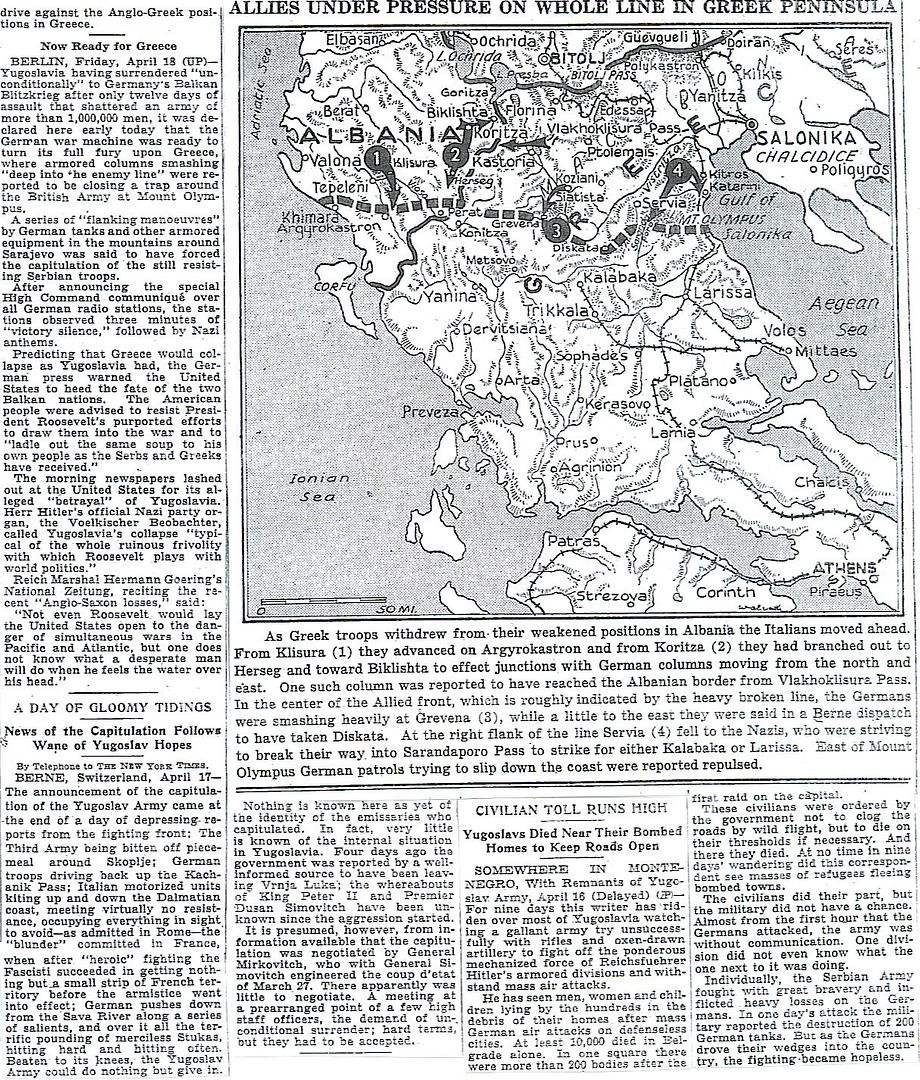
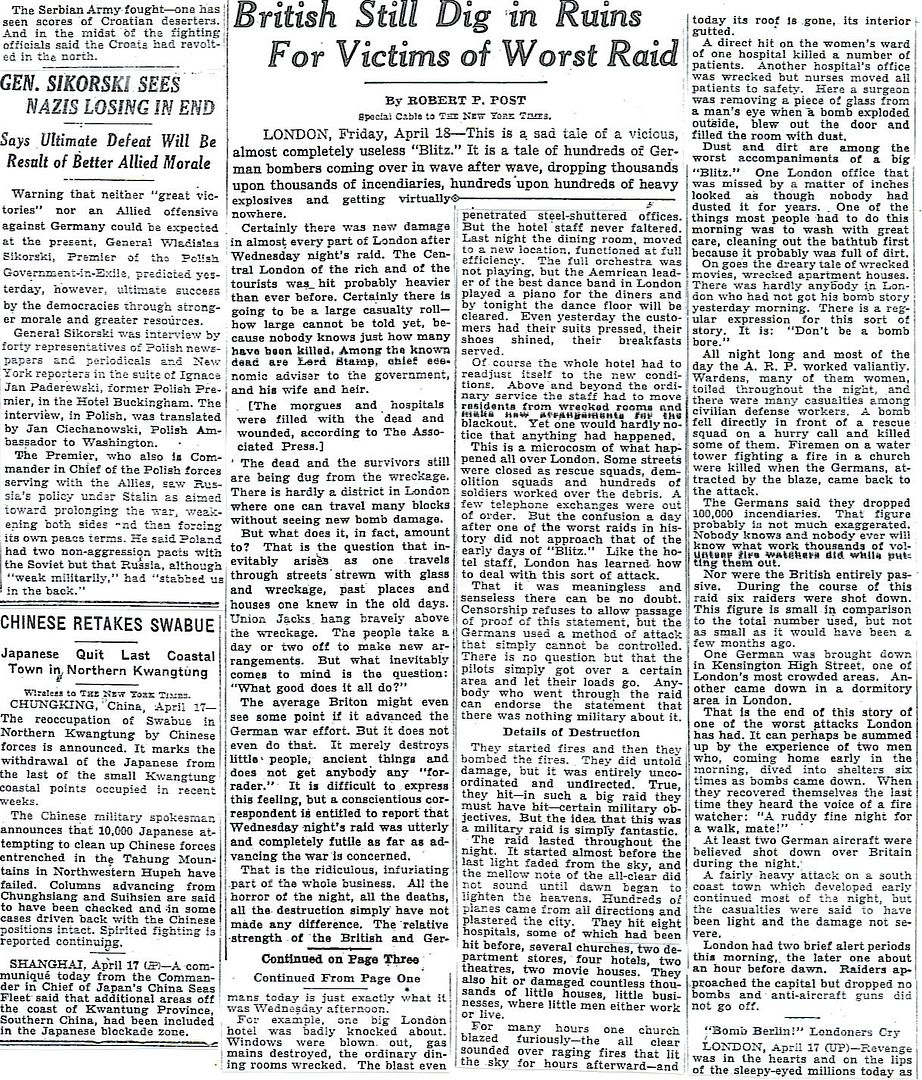
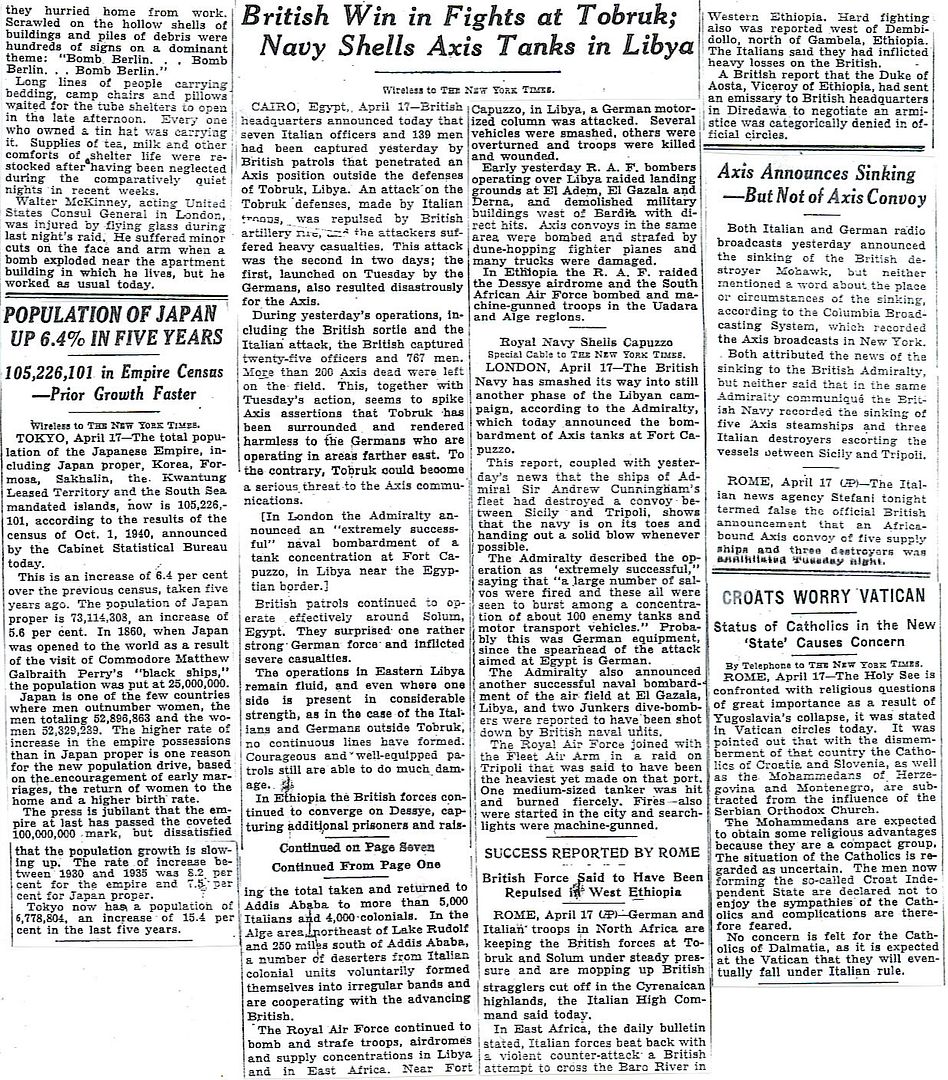
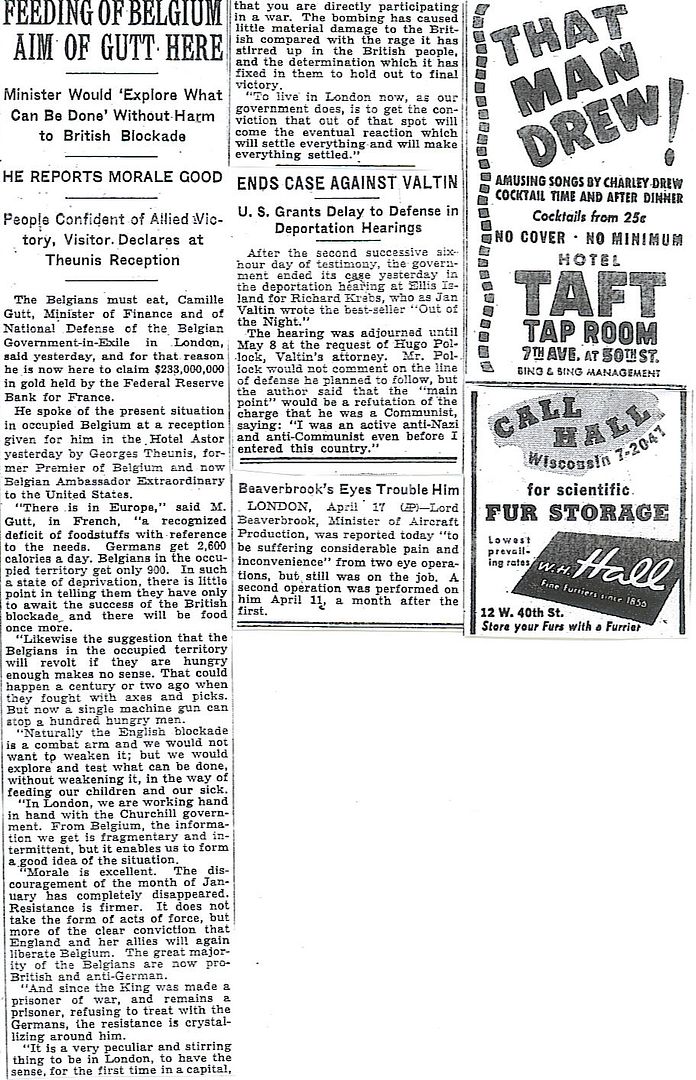
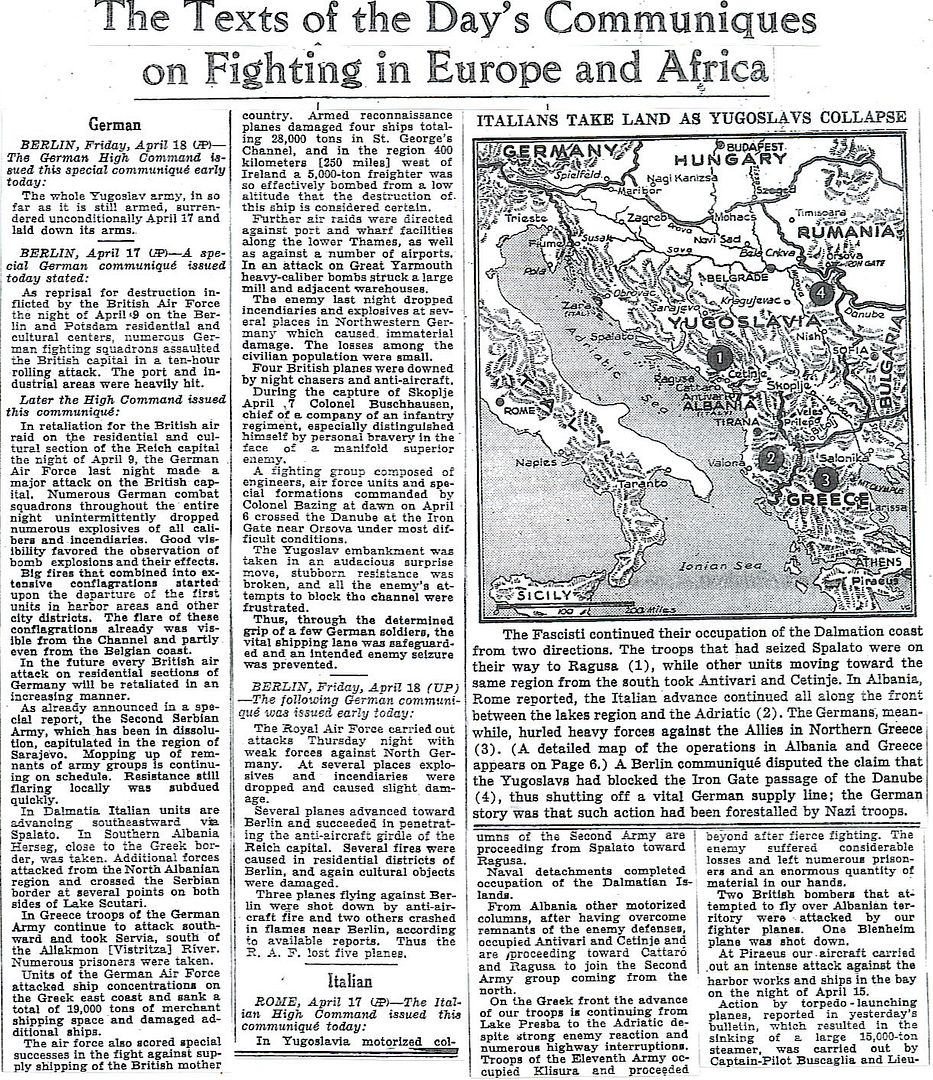
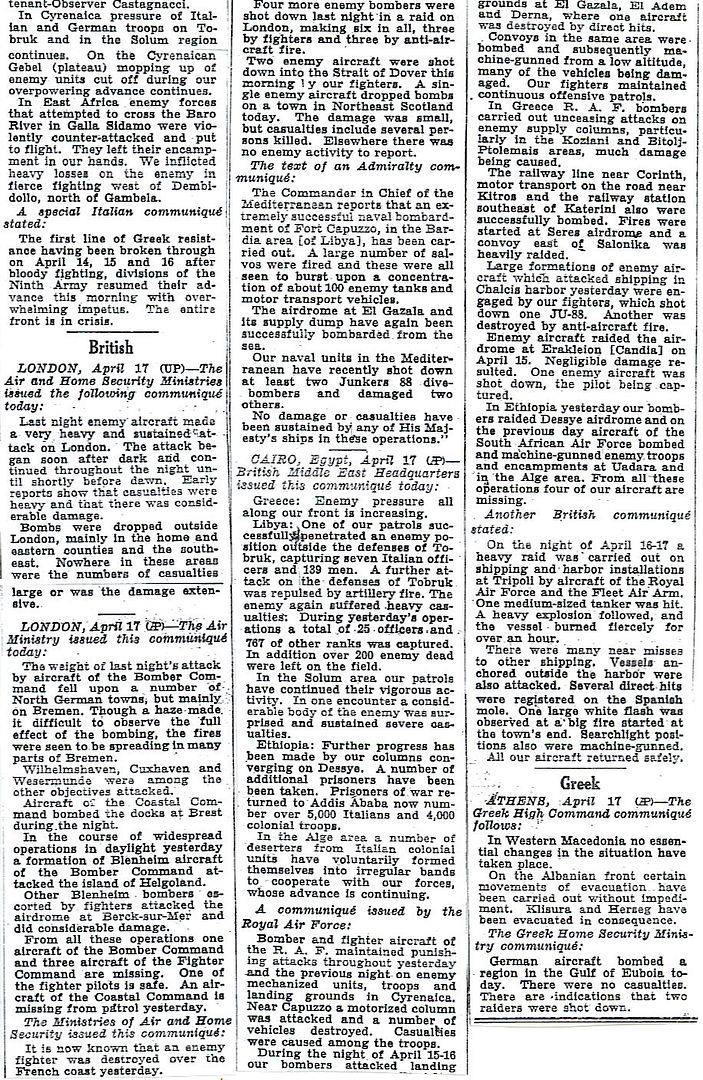
http://www.onwar.com/chrono/1941/apr41/f18apr41.htm
German planes strike retreating Allies
Friday, April 18, 1941 www.onwar.com
In the Balkans... The campaign continues in Greece, with the Olympus position abandoned by the Allies. The rearguard will be considerably harried by the Luftwaffe as they fall back on Thermopylae.
In Athens... Greek Prime Minister Korizis commits suicide.
http://homepage.ntlworld.com/andrew.etherington/month/thismonth/18.htm
April 18th, 1941
UNITED KINGDOM:
Churchill to CIGS:
After the capture of Benghazi ... the 7th Armoured Division, ... was ordered back to Cairo to refit. This involved a journey of over 400 miles, and must have completed the wearing out of the tracks of many of the tanks. It was an act of improvidence to send the whole division all his way back, in view of the fact that German elements were already reported in Tripoli. The whole of the tanks in this division could not have been all in a condition of needing prolonged heavy repairs. Workshops should have been improvised at the front for lighter repairs, and service personnel sent forward.
FRANCE: Vichy France quits the League of Nations. (Jack McKillop)
GERMANY:
Berlin: The German News Bureau reported:
At 9:00 P.M. on April 17, all the Yugoslav forces that had not yet been disarmed surrendered unconditionally. The surrender came into force at 12:00 today, April 18.
YUGOSLAVIA:
The Yugoslavs surrender after 12 days fighting.
GREECE:
Athens: The Greek Prime Minister, Alexander Korizis, commits suicide.
Athens: The Greek High Command announced:
Our position in West Macedonia has remained substantially unchanged. Our troops on the Albanian front have carried out an ordered retreat.
Thermopylae: Throughout daylight the Germans attacked the 16th Australian Brigade in the Pinios Gorge and the 21st Battalion 6th New Zealand Brigade at Elasson. The 16th Australian Brigade held the road until late that night but the German tanks forced the two battalions (2/2Nd and 2/3rd) of the 16th Brigade Australian Imperial Force into the hills. From the air, the Luftwaffe attacked the long lines of vehicles along the 70 miles escape route to Lamia. Although the air attacks continued all day and were noisy and nerve wracking, the Luftwaffe failed to exploit its superiority and was unable to halt the retreating column and did remarkably little damage to men and vehicles. (Anthony Staunton and Jack McKillop)
EGYPT:
Cairo: British Headquarters in Egypt announced:
Under growing pressure from the German forces receiving reinforcements daily, Greek and British troops along the Greek northern front are making a gradual retreat to a shorter defensive line.
FORMOSA:
Takao (Kaohsiung): A Mitsubishi G3M2 bearing no national emblems but belonging to No. 3 “Kukutai” Corps of the Japanese navy, takes off and sets a course for the US base at Legaspi on the Philippine island of Luzon. Keeping just outside the territorial waters 15 miles from shore they photograph the island of Luzon from 28,000 feet.
U.S.A.: General Motors, now producing 50% of U.S. cars, announces that it will make no changes in passenger-car models due to defence needs. (Jack McKillop)
http://worldwar2daybyday.blogspot.com/
Day 596 April 18, 1941
Greece. At the Pinios Gorge, 6th Mountain Division crosses Mount Olympus to get behind the ANZAC defenders while 3rd Regiment 2nd Panzer Division fords the Pinios River on a pontoon bridge. Germans are converging from 3 directions on the strategically-important crossroads at the town of Larisa, through which all Allied troops are withdrawing towards Thermopylae. Luftwaffe bombs and strafes the 70 mile long column of trucks on the road South but most Allied troops get away safely from the danger of entrapment. As it becomes obvious that the Allies are abandoning Greece, Greek Prime Minister Alexandros Koryzis shoots himself in the evening.
Iraq. 20th Indian Infantry Brigade land at Basra unopposed. They have sailed from Karachi, India, in 8 transport ships escorted by aircraft carrier HMS Hermes, cruisers HMS Emerald & HMNZS Leander, 6 sloops and gunboat HMS Cockchafer.
It is a quiet day at Tobruk after the fury of the Easter weekend. Rommel awaits the arrival of 15th Panzer Division’s heavy armour. Australian General Leslie Morshead (known as Ming the Merciless for his scowl), commander of the Allied garrison, insists on a defense in depth. He reorganizes his forces, creating additional reserve brigades, and continues construction of a secondary defensive line, digging gun pits and laying minefields. German dive bombers sink empty British troopship HMS Fiona (54 killed) 50 miles Northwest of Sidi Barrani, Egypt.
At 6 AM 1400 miles West of South Africa, German armed merchant cruiser Atlantis shells Egyptian liner ZamZam without warning, believing her to be a British troopship. ZamZam is carrying a cargo of lubricating oil, tin plate, trucks, steel bars, radios and batteries from New York, USA, to Cape Town, South Africa. All 129 crew and 202 passengers (including 73 women and 35 children) are rescued from lifeboats, during which Life magazine‘s David Sherman captures a photograph of Atlantis. A boarding party raids the larder and bar before sinking ZamZam with scuttling charges.
En route to the Mediterranean, British submarine HMS Urge sinks Italian tanker Franco Martelli in the Bay of Biscay. British destroyers HMS Newark and HMS Volunteer collide just off Northern coast of Ireland. Both are seriously damaged and will be under repair at Belfast until August.
While all this was going on and for the next few years, the KGB was recruiting Liberal Americans and setting up its structure in the State Department and other key government agencies. They were heavily influencing favor toward Tito in Yugoslavia and Mao Tse Tung in China over their conservative opposition (our friends in the world) and convinced the American public that “Russia is our ally”.
They were laying the foundation for today’s NWO/Communist power structure within our government that backs Obama when he says so arrogantly to Congress, “You WILL pass that bill” and to the Republicans, in effect, “You want to oppose me? Come on - bring it on”.
See “Blacklisted By History” by M. Stanton Evans.
Churchill points out another structural weakness in the British armor TO&E: a lack of tank transport vehicles and units. One of the Brits’ continuing problems will be track wear, and engine wear because British Armor goes everywhere, unless on rail transport [no matter the distance], on its tracks.
It's hard to imagine what would have happened to German panzers had they used the same strategy in Russia. If memory serves me right were not most German armored vehicles transported by rail, especially reserves and replacement vehicles? I also recall that the Germans had tank and other repair depots fairly close behind their advancing armor whenever possible.
This is an interesting story so I have posted the German version which was taken from the book-The German Raider Atlantis by Captain Bernhard Rogge As you have already related the description of the raider by Murphy had a lot to do with the eventual destruction of the ship.
At about four o'clock in the morning, barely an hour after we had parted from the Dresden (German supply ship), we sighted a fairly large ship on a south-easterly course. She was completely blacked-out but in the brilliant moonlight was easily identified as a merchant ship. Very soon we were able to make out four masts and I remembered having seen some ships of the same type in Dartmouth during the Coronation festivities before the war. I recalled the scene vividly. I had asked the British officer acting as my guide, 'What are those four-masted ships over there—what do you use them for? Auxiliary cruisers?' He had replied: 'Those are Bibby liners, troop-transports from the Great War. We are still using them as such, for there are always troops that have to be moved somewhere.' I was sure that this was a Bibby liner. She steamed so close to the Dresden that the latter promptly turned tail and fled, while the Bibby ship suddenly started to zigzag as though she had sighted us and was trying to escape. It was only hours later that we learned that there was no question of her trying to flee—it was merely that her helmsman was an Egyptian!
Her size and suspicious movements made me wonder whether she was in fact being used as an auxiliary cruiser, and as we followed cautiously in her wake, I made up my mind to get within range of her at daybreak and make a surprise attack. I wanted at all costs to prevent her from sending an SOS, as the South Atlantic was narrower and better patrolled than our previous operational area; our only hope was to attack with every gun that would bear. My plans had to be expedited when the ship began to transmit a signal—quite a harmless one at first, What station is that?'—but we could not know whether her next one would be 'QQQ' or 'RRR'. The ship was now standing out clearly against the early morning sky and we identified her definitely as one of the Oxfordshire class, though we still could not see whether she was armed nor could we distinguish the colours of her ensign. I hesitated no longer and at 9,200 yards opened fire. The second salvo was on target and one shell smashed the wireless cabin; she was hit six times in all, sustaining heavy damage on the waterline and in the engine-room. The ship at first turned away, then stopped, blew off steam and lowered her boats. She made no SOS signal—her wireless cabin was a heap of ruins. We ceased fire.
Here is how one of my officers afterwards described the scene:
'Day was breaking as Atlantis approached the enemy ship; the first rays of the sun shone on the gently heaving swell where the ship lay with a heavy list. She was the Zam Zam, 8,299 tons, previously known as a Bibby Line troop-transport under the name of Leicestershire and later as the British Exhibitor; for some years she had been serving as the largest ship in the Egyptian merchant navy. Boats were drifting about everywhere, some fully laden, others floating keel upwards. People were clinging on to them. Some of the boats were only half full; thin brown men with terror-stricken faces were squatting in them —the Egyptian crew, who had rushed for the boats without bothering about the passengers. As the German motor boats moved towards the Zam Zam they let out wild cries for help, but the Germans paid no attention, being intent on rescuing first the women and children and those who had been left on board the badly damaged ship.
'It was no easy task. The shark-infested waters were full of men and women swimming about. One mother had taken off her life-jacket and put her little son on it; holding him on with her hands, she was struggling towards the boats. It was a miracle that nobody was drowned. The scene on board the Zam Zam was shocking. All the boats on the port side were still hanging from the wrecked davits, riddled with shell-holes. The great mirrors in the dining-saloon and smoking-room had been shattered and the tables hurled in all directions. Big black holes gaped where the shells had exploded.
'While in Trinidad, the Zam Zam had received orders from the British Admiralty to follow a prearranged course across the Atlantic. The master's request to be allowed to steam with his lights burning at night because of the presence of women and children on board had been refused; the ship was carrying a British cargo and therefore had to conform to the regulations. Among the two hundred and two passengers were seventy-seven women and thirty-two children; one hundred and forty of them were American, the rest were nationals of Canada, Belgium and various other countries. Amazingly enough, our shelling had not caused the loss of a single life and with the exception of three serious casualties, no one was hurt. This miraculous escape was attributed to very different causes by the Christian missionaries and by those of the Moslem faith (Zam Zam is the name of a holy well in Mecca).
'The working-parties did their best to transfer all the passengers' luggage, the fresh food, tobacco, crockery, mattresses and blankets, for the ship had a heavy list and was filling rapidly as water rushed through the shell-hole in the engine-room. The boats that returned empty from Atlantis were quickly filled with articles of clothing and trunks seized at random from the upper deck cabins; armfuls of coats and trousers were snatched from cupboards and flung into the waiting launches. As the last boat came alongside, laden to the gunwale, the raider's decks looked like a gipsy's caravan or an emigrant ship. The passengers crowded together on the boat deck and watched the Zam Zam being sunk. Some of those who had come on board in their pyjamas were barefooted, wearing dressing-gowns borrowed from the German officers. Children were shrieking, crying or laughing, mothers were wringing their hands, babes in arms were peering mutely at the confusion around them. The children were highly delighted with this new adventure; the grown-ups were less enthusiastic. Most of them had lost many of their possessions, some of them everything. The German officers were besieged with questions from all sides.
On learning that there were more Americans among the Zam Zam's passengers than there had been in the Lusitania in 1916, I realized at once that the capture of this Egyptian ship could be turned to excellent account by that section of the American Press which was trying to force the United States into the war. Properly handled, the case of the Zam Zam could be made into the Lusitania story of the Second World War. It was therefore all the more important to impress the Americans with our generosity and sense of chivalry. As luck would have it among the pasengers were a travelling American journalist, Charles Murphy, editor of the magazine Fortune and a prominent contributor to Time and Life, and a Life photographer named Scherman; it was certain that neither of them would ignore the chance of making the most sensational scoop of their lives. Murphy's eye-witness account of the capture and sinking of the Zam Zam would have the greatest influence on public opinion in the USA and might in fact be used in support of the isolationist group.
My intention was to transfer the Americans and all the women and children to the first neutral ship we encountered, or alternatively to send the Dresden to Las Palmas or Teneriffe in the Canary Islands; but the Naval Staff would not agree to this and the Dresden was ordered to make for Western France, where in fact she arrived on 20th May, 1941. Two days before that—a full four weeks after the ship had been sunk—the British Admiralty announced that the Zam Zam had been overdue since 21st April. The American Press's reaction was extraordinarily quick: 'LINER ON PASSAGE TO AFRICA DISAPPEARS. 142 AMERICANS PERISH?' 'The Zam Zam carried distinctive neutrality-markings,' said the New York Times, adding, "There are no waters undefiled by the Nazi pirates, no flag which they will respect . . . .' On the other hand there were newspapers which spoke of '. . . exemplary adherence to the prize regulations ... no member of the crew nor any passengers lost their lives ... it is being stressed in Washington that the German ship acted in accordance with the rules of war in taking passengers and crew on board before sinking a ship that was carrying contraband goods. . . .'
Disclaimer: Opinions posted on Free Republic are those of the individual posters and do not necessarily represent the opinion of Free Republic or its management. All materials posted herein are protected by copyright law and the exemption for fair use of copyrighted works.